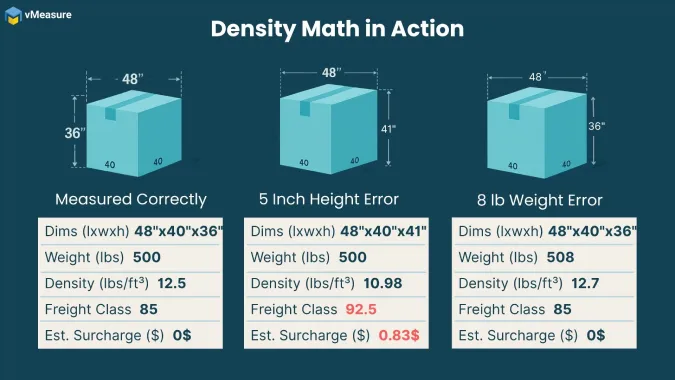Ready or not, freight classification is about to get real.
With NMFC Docket 2025-1 taking into effect on July 19, 2025, the freight shipping industry is entering a new phase — one defined by tighter rules, stricter enforcement, and zero room for guesswork.
That means accurate dimensions, up-to-date NMFC codes, and density-based class assignments that can hold up under audit.
What used to be a flexible, sometimes negotiated process is now a clear line: you’re either compliant, or you’re not. And the carriers now have the tools to tell the difference.
So, what’s actually changing — and why does it matter for compliance?
What’s changed and why it’s a compliance issue?
The National Motor Freight Classification (NMFC) system is moving to a more precise, data-driven model. Two major shifts are at the heart of it:
- A new 13-tier density scale
Freight is now more tightly grouped by actual density. Even small changes in dimensions or weight can bump a shipment into a different class — and with it, a different rate. - The introduction of commodity-specific identifiers
Generic categories like “plastic articles, NOI (Not Otherwise Indicated)” are being phased out. Every item now needs a specific NMFC code that reflects how it’s packaged, handled, and stowed. The days of assigning a class based on habit or “what we’ve always used” are over.
Together, these updates raise the stakes. Freight that’s misclassified, even unintentionally, is now much easier for carriers to detect and correct.
That turns a misclassification from a minor billing correction into a compliance issue with real operational consequences, straining carrier relationships.
Why manual measurement is now a compliance risk?
Manual freight measurement has always had its flaws. Whether it’s a tape measure, a floor scale, or even a rough visual guess, inconsistencies in how freight shipments are measured open the door to misclassification, rework, and re-rates.
Just a 5-inch height error over an 8-pound weight discrepancy can push a shipment into a different class.

Carriers are using automated systems to verify shipment specs. If your declared values don’t match, you risk more than a correction — you risk being labeled non-compliant.
How does freight misclassification really happen?
Most freight misclassification isn’t the result of negligence. It’s the result of outdated habits, assumptions, or systems that haven’t kept pace with the new rules.
Freight Misclassification in 2025 often looks like:
- Reusing outdated NMFC codes from old shipments without verifying updates
- Estimating dimensions or rounding to save time
- Using generic legacy categories like “plastic articles, NOI” instead of the correct identifier
- Forgetting to remeasure after packaging changes
- Copy-pasting BOLs without updating dimensions or weight
- Lack of staff training on how density directly affects freight class
Repeat these errors and you’re breaking compliance. Carriers are watching more closely than ever — and they’ve made it clear:
“When one or two inches can change your freight class and pricing model, there’s no room for guesswork.”
– Mark Davis, VP of Pricing, Averitt Express
(Source: Averitt.com, NMFC Docket 2025-1 commentary) How to stay compliant with NMFC 2025?
Compliance under NMFC 2025 is about building freight operations that run clean, fast, and dispute-free more than checking boxes.
Here’s what that looks like in practice:
Freight moves without surprises
When your class is right the first time, there are no re-weighs, no re-rates, and no shipment holds. Carriers don’t flag your freight — they move it.
Invoices match the quote — every time
When weight, dimensions, and class are correct at origin, there’s no need to reconcile billing later and shortens your cash cycle. Carriers trust your data
If your shipments consistently match what you declare, you’re not seen as a risk. That can mean better pricing, fewer audits, and stronger relationships over time. Your systems apply the right data
Get your TMS or shipping software updated with new NMFC data and real-time dimensions from automated dimensioning systems to determine accurate density. You verify every classification
Tools like ClassIT® make it easy to confirm NMFC codes and freight classes before shipping — eliminating guesswork and legacy errors. Why are dimensioning systems now critical to freight compliance?
When compliance depends on exact weight, dimensions, and density, shippers need more than good intentions. They need tools that make precision automatic.
That’s where automated dimensioning systems come in.
Unlike manual measuring tapes or floor scales, pallet dimensioning systems use computer vision to capture exact dimensions and weight — in seconds — with consistency and accuracy. They push the dim data to your TMS, WMS or shipping software powering correct density calculations, and therefore, helps in identifying correct freight class.
If you’re looking for industry’s best dimensioning systems ahead of the NMFC rollout, look for:
- Certified accuracy (NTEP/Legal-for-Trade status)
- Real-time data capture (ideally sub-second)
- Integration-ready with your existing TMS or WMS
- Support for pallet and parcel measurement
- Reliable data storage or cloud access
These systems ensure the class you apply for is the class your carrier accepts — minimizing rework and protecting your shipping margins.
What to do before July 2025?
Don’t wait until July — here’s what you should prioritize now:
1. Audit your classification process
- Identify gaps in measurement practices
- Validate how density is being calculated
2. Run a pilot with a dimensioning system
- Test and compare results side-by-side with your manual method
- Use findings to guide your investment on dimensioning systems
3. Collaborate with partners
- Discuss updated procedures with your carriers and 3PLs
- Make sure all parties are aligned by 15th July 2025
4. Tap into NMFTA (National Motor Freight Traffic Association) resources
- Use ClassIT® to review NMFC updates and commodity code lookups
- Follow webinars and shipper-focused learning sessions
If you’re still relying on manual dimensioning methods, now’s the time to upgrade. Dimensioning systems are now your insurance policy against misclassification, billing disputes, and lost credibility. Because in 2025, the only thing tougher than the rules… is the cost of getting them wrong.